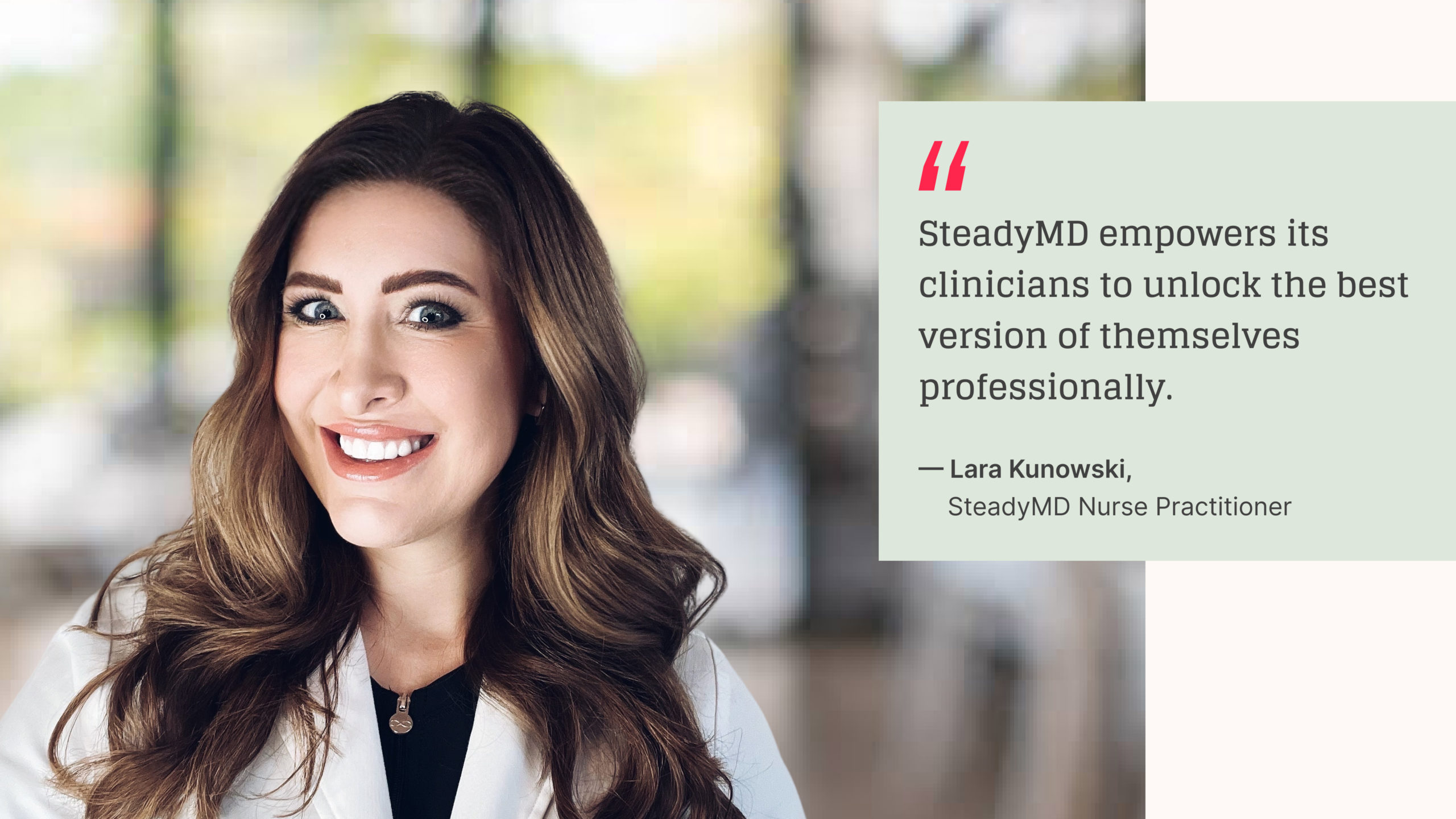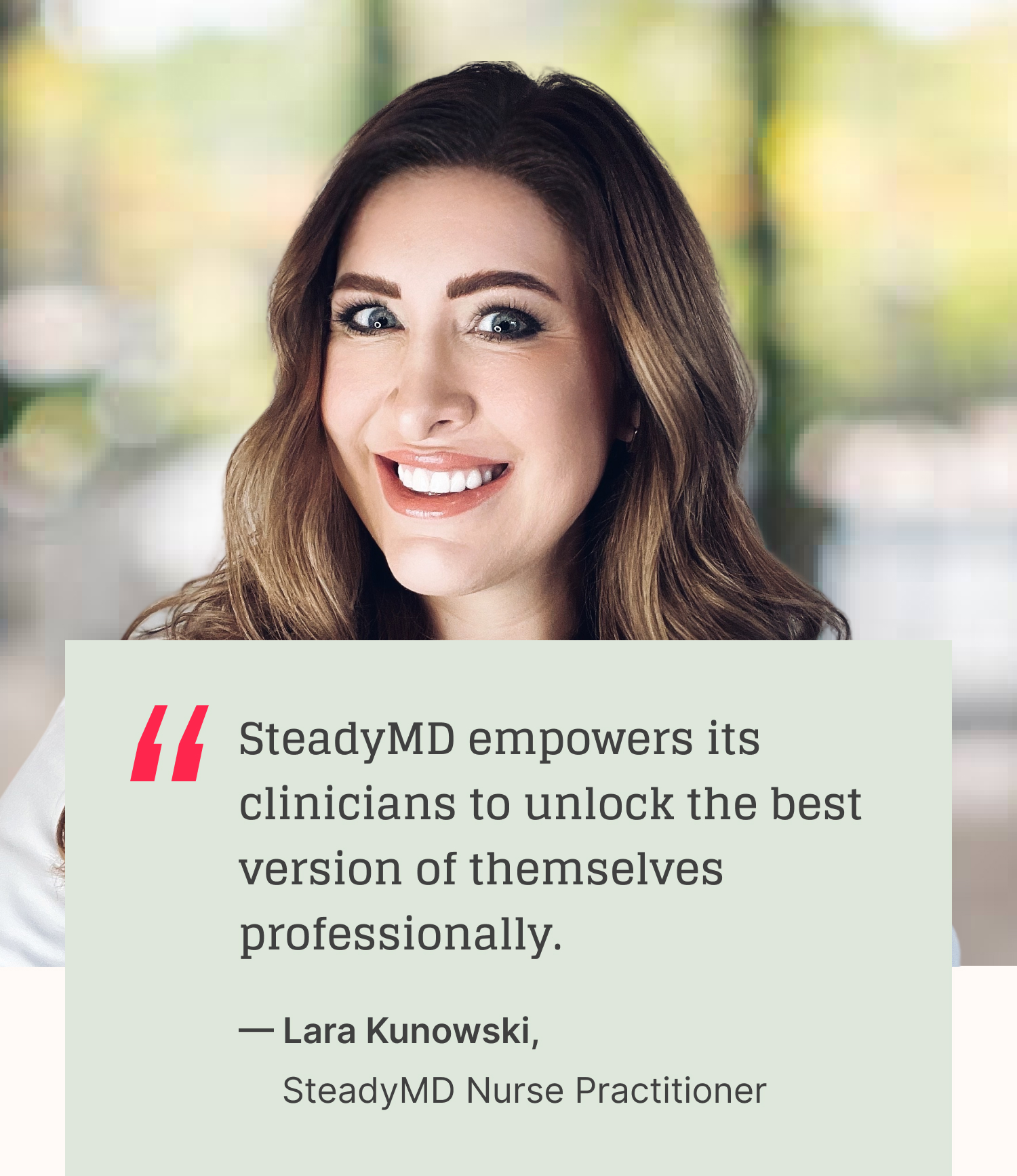Lara Kunowski, FNP
Family Nurse Practitioner, Telehealth Evangelist


We sat down with Lara Kunowski, FNP, who has been working with SteadyMD for over a year as a licensed nurse practitioner. She shared what she loves most about being a nurse, the work-life benefits of the virtual care model, and what about telemedicine she finds exciting.
What inspired you to become a nurse?
My mom was actually a nurse, and watching her work while I was growing up sparked my initial interest in becoming one myself. I certainly had moments in life where I thought about other careers, but I knew nursing could provide the flexibility and fulfillment I was ultimately looking for. This career also offers a lot of options and roles to step into, from HR to floor nursing, office nursing, nurse practitioner, etc. That was very appealing to me.
I originally went to school to become a certified registered anesthetist, but after trying it out for about 18 months, I discovered that it wasn’t the right fit for me. I transitioned from that program to the nurse practitioner program, and I loved it from the start – I was able to actually connect with patients instead of putting them to sleep!
I also battled some health issues from a very young age, which served as additional inspiration for my work as a nurse today. I was born with a hole in my heart, which created some troubling cardiac issues. While navigating that condition, I received a lot of one-on-one care from nurses in hospital settings — and those interactions were hugely inspiring to me early on in life.
What initially drew you to SteadyMD?
I had already grown interested in telemedicine before joining SteadyMD because I believed it could help alleviate some of my work-life balance pain points as a nurse and enable me to spend more time with my kids. I often felt guilty for working full-time away from them. When I discovered that I could sustainably work for SteadyMD from my home office, I was immediately drawn in. Some individuals, like my husband for example, spend so much time commuting to and from the office every day that they could work an extra full day with the time they spend on the road. Now, with SteadyMD, I always joke that my commute is just down the hall. You can also live or travel anywhere while working in telemedicine, which — for us — has been a blessing that allows us to visit out-of-town family and work simultaneously, sometimes for prolonged periods of time. There’s also been a substantial amount of growth at the company and throughout the industry since I first started working with SteadyMD. I find it promising that the company is constantly expanding and adding new clients.
What do you appreciate most about working with SteadyMD?
With SteadyMD, there’s constant encouragement and motivation to be the best version of yourself — as both a person and as a clinician. We’re consistently supported through the company’s ongoing educational training across various healthcare-related topics.
“I really feel supported and empowered here. I’m always offered help and advice from other colleagues, including upper management.”
What does an average day in your life at SteadyMD look like?
Given that the company is always expanding, I stay flexible, knowing that each day will be a little different from the last. When SteadyMD onboards new partners, we learn and study the different platforms and protocols that are associated with the new business. We also strive to not just make our partners happy, but their patients happy as well, which gives me a lot to manage — so it can be hard to pinpoint exactly what a “normal” day would look like. One day I may primarily focus on one program, whereas another day I am working among multiple programs. This also varies between clinicians, as we each have different programs we are assigned to and it changes from time to time.
Can you share a truly standout moment from your experience here thus far?
Recently, I saw a patient with an ear infection. She was previously prescribed antibiotics, but while she was describing her symptoms to me, she mentioned that her jaw was also hurting and swollen and she was having a difficult time eating due to the pain. As I listened, I quickly realized that this wasn’t just a standard ear infection. Something else was going on. I soon realized that she had a parotid duct obstruction. I’ve only seen this one other time. It occurs when the salivary gland is obstructed. We were able to walk through those details together, and I could see that she felt much better knowing I could help her with something that she couldn’t figure out alone. We went on to discuss different ways to alleviate the pain, and it felt good knowing that — by just listening closely to her and being open to everything she shared — we were able to properly assess the condition she was actually dealing with. We then developed a plan of care going forward that included pain relief and following up with an ENT specialist to evaluate and treat the condition.
In your opinion, what qualities can help a nurse thrive in virtual care?
Generally, you really need to be a people person and a good listener at heart. And be flexible!
“Empathy is at the core of what we do, and I feel like it allows me to have a lot of fulfilling moments with my patients.”
What are some of those upsides that can make your job easier?
With telemedicine, the distractions that can arise in clinical settings are eliminated, so you’re able to focus more closely and completely on the patient at hand. You can take the extra time to really listen to them, answer their questions, and provide insightful informative care and aftercare instructions following the visit. The truth is, not every health issue requires a patient to come into a clinic, and the virtual connection allows patients to feel more at ease and that they are the center of your attention when you’re speaking with them.
Do you have any advice for other clinicians who may be thinking about going into telehealth but have yet to take the leap?
I would definitely recommend telehealth to those who are still on the fence. I’ve already mentioned the huge work-life benefits of saving a costly commute, having more flexibility to spend time at home with one’s family, and the ability to travel while working. But there’s also increasingly more that can be done within the telemedicine modality, which allows a clinician to continue to grow professionally and treat a wide range of conditions that they may never see while working at one particular location or practice. For example, my background is in urgent care, dermatology, and aesthetics, but since working with SteadyMD, I’ve expanded my knowledge and skill set to be able to effectively treat conditions that fall within primary care, women’s health, and mental health specialties. I’ve also been able to treat conditions virtually that vary based on demographics or locations outside of my own immediate community. For example, Lyme disease is much more common in the Northeast, and I had yet to treat it prior to SteadyMD, as I’m based out of Texas. I’ve also gained more knowledge and experience treating patients within the LGBTQIA+ community and have enjoyed learning more about how to better serve that patient demographic.
“It’s rewarding to be able to offer unbiased medical services to vulnerable populations who often feel misunderstood, misgendered, and limited in terms of the quality and access to care that is available to them.”
What do you say to those who assume telehealth can feel isolating?
The so-called “isolation” doesn’t really bother me, because I’m constantly communicating with patients. SteadyMD keeps me pretty busy, too, so the day never gets dull or drags on for too long. Of course, there will always be tradeoffs in any direct comparison, but I think the advantages of virtual care outweigh any potential disadvantages. Especially in the time of COVID-19, where telehealth enables clinicians to effectively treat patients without having to work in a mask all day or risk exposing themselves or their family to this and other highly transmissible viruses. I’ve found new ways to be both personable and professional with patients through telehealth, and I actively worked for a year to be in the position I’m in today. After my last company, I took it upon myself to pay for my licenses so that I could eventually have a job where I work from home. So, for me, making the move has always been worth it.
What was the onboarding experience like with SteadyMD?
It was very intuitive. SteadyMD makes the process easy and has really fine-tuned the virtual aspects of the job. All of my interviews were also virtual, which I appreciated, as many jobs require you to travel somewhere and meet in-person when onboarding. There have also been instances where the company didn’t need as many hours from me for patient care, which opened the door for me to put my time toward other aspects of the job, including understanding protocols, completing CEUs, and broadening my overall knowledge, which allows me to offer the most up-to-date and reliable care to my patients. I love that there’s always something of value that we can do virtually to make use of our time.
Outside of your work, what are some of your hobbies and interests that drive you?
I always laugh at myself when I say this, but the truth is, one of my favorite pastimes has always been just watching TV because who doesn’t love Netflix in their free time? Because I have kids, I primarily watch cartoons now. But, that’s okay, I’m also definitely still a kid at heart, and one of my favorite things to do is to go to Disney World. Now, I get to bring my kids and family with me, and spending time with them will always be my #1 favorite pastime. I also like to travel to see my extended family whenever I get the opportunity, which is more often now. On a day-to-day basis, I enjoy exercising and focusing on my health as much as I can within my time constraints.
What excites you most about being a clinician in 2022?
I’m really excited about the growth of telehealth, in general. There are increasingly more conditions that are being treated via telemedicine, and there’s so much out there to learn about how to treat patients virtually. Even the consumer tech that so many people already wear or have access to at home (Apple Watches, FitBits, etc.) enable us to easily capture many of the standard vitals virtually. Through our urgent care partners, I can see a larger variety of patient cases, which keeps the work interesting.
I genuinely feel like I’m seeing and learning a lot more through telemedicine than I did when working inside of a clinic due to the spectrum of patients we can serve virtually across multiple practices.